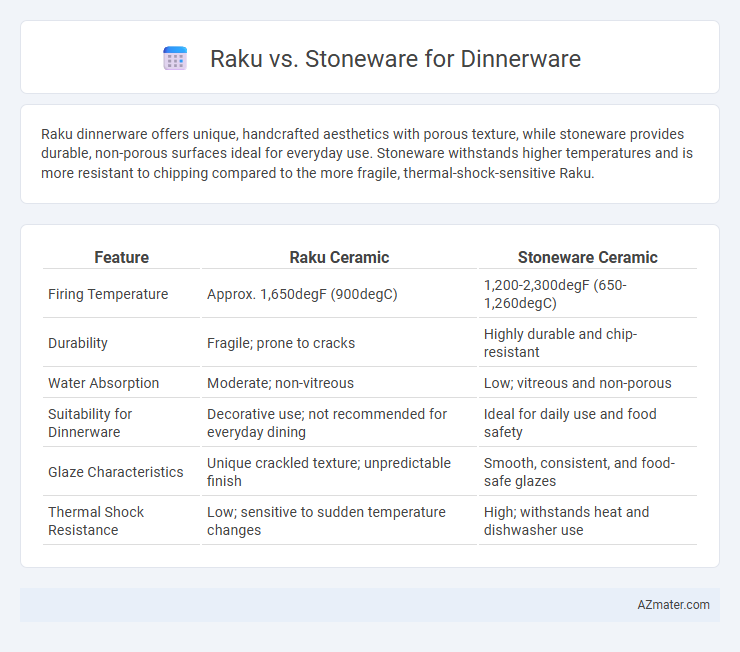Raku dinnerware offers unique, handcrafted aesthetics with porous texture, while stoneware provides durable, non-porous surfaces ideal for everyday use. Stoneware withstands higher temperatures and is more resistant to chipping compared to the more fragile, thermal-shock-sensitive Raku.
Table of Comparison
| Feature | Raku Ceramic | Stoneware Ceramic |
|---|---|---|
| Firing Temperature | Approx. 1,650degF (900degC) | 1,200-2,300degF (650-1,260degC) |
| Durability | Fragile; prone to cracks | Highly durable and chip-resistant |
| Water Absorption | Moderate; non-vitreous | Low; vitreous and non-porous |
| Suitability for Dinnerware | Decorative use; not recommended for everyday dining | Ideal for daily use and food safety |
| Glaze Characteristics | Unique crackled texture; unpredictable finish | Smooth, consistent, and food-safe glazes |
| Thermal Shock Resistance | Low; sensitive to sudden temperature changes | High; withstands heat and dishwasher use |
Introduction to Raku and Stoneware Dinnerware
Raku dinnerware is crafted using a traditional Japanese pottery technique characterized by rapid firing and cooling, resulting in unique crackled glazes and earthy textures that make each piece distinct. Stoneware dinnerware is known for its durability and versatility, fired at high temperatures to create dense, non-porous surfaces ideal for everyday use and resistance to chipping. Both materials offer functional and aesthetic qualities but differ significantly in production methods and finish, influencing their suitability for various dining experiences.
Material Composition: Raku vs Stoneware
Raku dinnerware is crafted from porous, low-fired clay that undergoes rapid cooling, resulting in a less vitrified, more fragile surface with unique crackle patterns. Stoneware, by contrast, is made from dense, high-fired clay containing feldspar and quartz, producing a non-porous, durable, and chip-resistant finish suitable for everyday use. The fundamental difference lies in Raku's open-pore, decorative aesthetics versus Stoneware's robust, vitrified composition optimized for long-term functionality.
Firing Processes Compared
Raku dinnerware undergoes a low-temperature, rapid firing process followed by immediate removal from the kiln and rapid cooling in open air or combustible materials, resulting in unique crackled glaze patterns and increased porosity. Stoneware is fired at higher temperatures, typically between 1200degC and 1300degC, in a controlled kiln environment, producing a dense, vitrified, and highly durable ceramic body ideal for daily use. The contrast in firing temperatures and cooling methods between Raku and Stoneware directly influences their durability, aesthetics, and usability in everyday dining settings.
Aesthetic Differences: Surface and Color
Raku dinnerware features unpredictable, crackled surfaces with metallic and smoky hues that create a unique, rustic aesthetic with an organic texture. Stoneware offers a more uniform, smooth surface with earthy tones ranging from warm browns to muted grays, lending a classic and sturdy appearance. The vibrant, varied glaze patterns on Raku contrast sharply with the consistent, matte finish typical of stoneware.
Durability and Everyday Use
Stoneware offers superior durability and resistance to chipping, making it ideal for everyday use and frequent handling in busy kitchens. Raku, while prized for its unique aesthetic and handcrafted appeal, is more fragile due to its porous structure and lower firing temperature, limiting its practicality for daily dining. For long-lasting, dependable dinnerware, stoneware remains the preferred choice for most households.
Food Safety and Toxicity Concerns
Raku dinnerware, often handmade and fired at low temperatures, can be porous and prone to cracking, raising concerns about food safety due to potential absorption of liquids and harboring bacteria. Stoneware, fired at high temperatures between 1,100degC and 1,300degC, is vitrified and non-porous, making it more resistant to chipping, cracking, and safe for everyday food use. Stoneware's durability and non-toxic glazes reduce risks of leaching harmful substances, whereas Raku pieces may contain metallic glazes that can pose toxicity issues if not properly sealed.
Heat Resistance and Microwave Suitability
Raku pottery typically exhibits lower heat resistance and is not recommended for microwave use due to its porous nature and thermal shock sensitivity, which can cause cracking. Stoneware offers superior heat resistance and is microwave-safe, making it more practical for everyday dining needs involving reheating or hot food service. The durability and non-porous composition of stoneware provide better performance in high-temperature environments compared to Raku.
Cleaning and Maintenance Needs
Raku dinnerware requires delicate cleaning due to its porous surface and susceptibility to thermal shock, necessitating hand washing with mild detergents and avoiding soaking to prevent damage. Stoneware offers superior durability and typically resists staining and chipping, allowing for dishwasher-safe cleaning and low maintenance. Choosing stoneware minimizes upkeep efforts, while raku dining pieces demand careful handling to preserve their unique glaze and texture.
Cost and Accessibility
Raku dinnerware typically commands a higher price due to its handcrafted nature and unique firing process, making it less accessible for everyday use. Stoneware offers a more affordable and widely available option, manufactured in larger quantities with consistent durability suitable for regular dining. Cost-effective stoneware dinnerware is commonly found in retail stores and online, providing greater accessibility compared to the artisan-focused Raku pieces.
Which is Better for Dinnerware: Raku or Stoneware?
Raku and stoneware differ significantly in durability and aesthetic appeal, with stoneware offering superior strength and chip resistance suitable for everyday dinnerware use. Raku, known for its unique, artistic glaze patterns and porous surface, is better suited for decorative or occasional use rather than daily dining due to its fragility and sensitivity to thermal shock. For practical, long-lasting dinnerware, stoneware's vitrified, non-porous finish ensures ease of cleaning and microwave safety, making it the better choice for functional dinnerware sets.

Infographic: Raku vs Stoneware for Dinnerware
 azmater.com
azmater.com